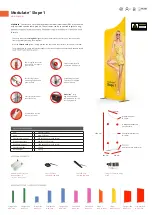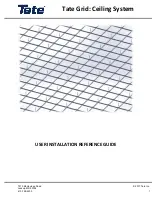
6
When conducting the crossover please take care
that the ropes are not crossed. They must be
parallel.
Never carry out work with this product if, as a result
of your physical and mental condition,
your safety might be compromised in scenarios of
normal use or in emergencies!
Do not place this product near sharp edges!
Care should be taken to ensure that the rope (or
any other part of the system) is routed away
from surfaces that may damage the rope (or any
other component), or that suitable and sufficient
protection is appropriately placed to ensure the
rope and other components are protected.
Keep away from surfaces which may cause damage
to the the work equipment e.g.sharp or
abrasive surfaces or edges.
The anchor device shall be used for personal pro-
tective equipment and not for lifting devices -
as in rigging operations!
NOTE:
The Prusik Loop with thimble contains a
core of Dyneema
®
fibers that are not heat
resistant. When installed correctly, the friction hitch
is positioned where needed and remains in
that position. Movement of a loaded friction can
lead to heat build up through friction/abrasion.
Heat build-up (>60°C) must be avoided.
Use according to ANSI Z133-2012:
ANSI Z133-2012 requires arborist climbing lines (i.e.
lines designated to support the climber while aloft
in a tree or attached to a crane) to have a minimum
diameter of 1/2 inch (12.7mm) with the following
exception: In arboricultural operations not subject
to regulations that supersede Z133.1, a line of not
less than 7/16 inch (11 mm) diameter - like the line
present in this product - may be used, provided
the employer can demonstrate it does not create a
safety hazard for the arborist and the arborist has
been instructed in its use.
GRAB FUNCTION OF THE FRICTION HITCH
The friction hitch is a means of adjusting the length
of the anchor device. In adverse conditions or envi-
ronments, the function the product may be affected.
For example, greater care may be needed to ensure
that the friction hitch grabs reliably. Ice, mud, rain,
cold, snow and tree exudates are examples of loca-
lised or climatic conditions that may demand grea-
ter attention from the user. Beware, tree exudates
may create conditions similar to those made by lu-
bricants or adhesives. Contamination of ropes with
tree exudates may lead to rope hardening and red-
uce friction hitch grab reliability. Maintain ropes so
that their function is reliable. Ideally, ropes should
always be dry, clean and perform equally along their
entire length.
Great care shall be taken to ensure that objects
(such as leaves or twigs) are not trapped by the
friction hitch. Friction levels may be lowered, the
grab function may fail, resulting in a descent until
the friction hitch meets the stopper To minimise this
risk, users shall select the site of installation in the
tree (and other structures where debris may be en-
countered) to avoid this situation.
Check also at all times that objects (including ka-
rabiners, rope crossings, twigs etc.) do not contact
the top of the friction hitch and affect or eliminate
the reliable grab function. Modifications or additions
to this product, apart from replacement of the spare
parts as described above, are unacceptable, unless
done by the manufacturer.
Prior to every use, this product must be subject to a
visual inspection in order to verify its integrity, readi-
ness for use and proper functioning.
Once the product has been subject to a fall, its use
must be discontinued immediately. If the slightest
doubt remains, the product must be retired or may
not be used again until a duly compentent person,
having subjected such product to the required te-
sting and inspections, has approved its further use
in writing.
It must be ensured that the recommendations for
use with other components be complied with: ro-
pes need to meet EN 1891, while carabiners need
to meet EN 362 and any further PPE must meet
the harmonized standards under the regime of EU
guideline 89/686/EEC. Ensure all neighbouring com-
ponents are compatible. Ensure all components are
TO BE OBSERVED PRIOR TO USE
LIMITATIONS OF USE / SECURITY
fig. 8
fig. 9
LIMITATIONS OF USE







































